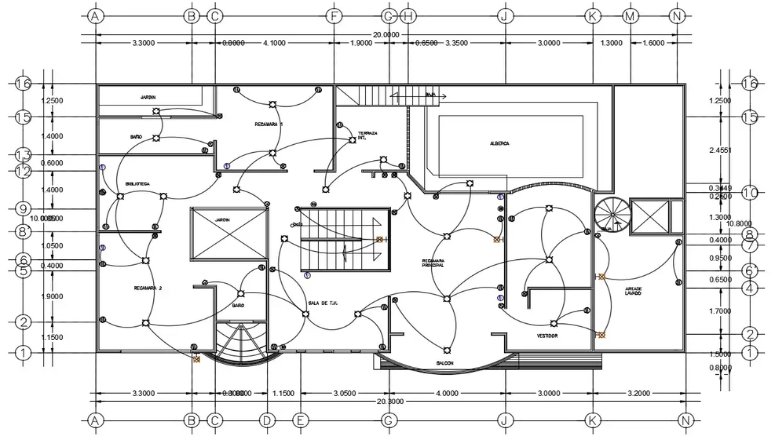In the current technological environment that is evolving at such a fast pace and where accuracy and safety are of utmost importance the services of electrical drawing are highly valued. Such services include drafting, drawings, analysis, and maintenance of complex drawings that show the electrical systems in various infrastructures.
Accurate electrical drawings are essential in industrial plants, commercial buildings, and residential complexes so as to ensure optimal performance, safety, and compliance with regulatory requirements.
Introduction to Electrical Drawing
Electrical drawing services refer to the production of detailed diagrams and schematics that describe the arrangement, wiring, and components of electrical systems.
These drawings are the maps for engineers, electricians, and technicians that lead them through the process of installation, maintenance, and troubleshooting. However, the advent of more sophisticated software tools has led to marked progress in the discipline of electrical drawing, allowing for more accurate and productive documentation of complicated systems.
Types of Electrical Drawings
The electrical drawings are blueprints for the installation, repair, and maintenance of electrical systems. They are used both by electricians and engineers in order to guarantee the accuracy and safety of electrical work. The 5 types of electrical drawings include:
Schematic diagrams:
Which offer a schematic figure of an electrical circuit, dealing with the interrelations between elements and their operation.
Wiring diagrams:
Visualize the arrangement of wiring and connections in a system which helps in installation and repair functions.
Layout drawings:
Provide a general description of how equipment is positioned, spatial arrangements, and the manner of placement of cables within a facility.
Panel drawings:
Describe the layout of control panels, switchboards, and distribution boards for ease of assembly and maintenance procedures.
Single-line diagrams:
Describe a simplified representation of power distribution networks, showing how electrical energy passes through different elements.
Tools and Software for Electrical Design
Technological development has changed the way electrical drawings are developed and handled. Modern engineering businesses are able to use a wide array of software tools custom-made for electrical design and documentation. Some of the most widely used tools include:
CAD (Computer-Aided Design) Software
A specialized version of AutoCAD, dedicated to electrical engineering work, with an extensive library of symbols and automated functions. This is fundamental to modern electrical drawing services as it enables great detail along with a scalable drawing.
Specific industry-browser programs — for example, AutoCAD Electrical — apply to the construction of electrical circuit diagrams, panel drawings, and various other types of electrical drawings that have quite exhaustive databases of symbols and components.
BIM (Building Information Modeling) Revit Software
BIM software such as Autodesk’s Revit, however, extends electrical drawing services beyond the services themselves and incorporates electrical designs into a building’s full context for 3D visualization, collaboration, and MEP Revit BIM Modeling services, which involve multiple disciplines.
KiCad
As an open-source EDA software suite, it offers schematic capture, PCB layout, and footprint creation tools.
Project Management and Collaboration Tools
With electrical drawing programs, project management software such as Microsoft Project or cloud-based platforms like Asana often gets integrated to keep every member of a team up to date and sync throughout a project lifecycle.
Therefore, choosing the appropriate package for the best utilization of such tools is vital in delivering superior electrical drawing services that can satisfy the requirements of efficiency, precision, and functionality.
Importance of Accurate Electrical Drawings
Accurate electrical drawings are essential for several reasons:
Ensuring safety standards:
Well-defined documentation makes it easy to identify any impending hazards and adhere to industry-specific regulations and safety requirements.
Avoiding errors in construction:
Precisely drawn plans effectively reduce the liabilities of costly errors during the construction stage, eliminating unnecessary rework in addition to project delays.
Facilitating maintenance and troubleshooting:
Detailed diagrams save time on maintenance work as technicians are more informed on how the system is configured and how it should operate.
Compliance with regulations and codes:
Electrical drawings have been legally required in several jurisdictions, requiring compliance with certain standards and codes of conduct to ensure public safety.
Process of Creating Electrical Drawings
The process of creating electrical drawings typically involves the following steps:
Gathering requirements: The client’s needs, project specifications, and regulatory requirements set the basis for drawing.
Initial sketching and brainstorming: Provisional drawing of preliminary sketches and overall layout of the arrangement of electrical components.
Using software for detailed drawings: Transcription of the initial sketches into detailed maps using special software tools, transforming them to symbols, labels, and measurements.
Review and revisions: Iterative reviews with stakeholders for testing accuracy, completeness, and compliance.
Key Components of Electrical Drawings
Electrical drawings comprise several key components, including:
Symbols and notation: Symbols for switches, relays, transformers, and capacitors are standardized based on their electrical components. This makes the diagram clearer and more consistent.
Wiring and connections: Visual representation of wiring connections, cable routes, and terminal locations helps to perform installation and troubleshooting tasks effectively.
Circuit diagrams: Circular network diagrams provide details on the flow of current through interconnected components, which helps in analysis and fault detection.
Equipment placement: By positioning equipment and devices within layout drawings, it is possible to provide effective space utilization and achieve the best system performance.
Standards and Regulations
Industry standards compliance and regulations are critical in the context of electrical design and documentation. Key standards and codes include:The only way to meet the needs of the fast-aging population would be to have a generation of workers who also grow old and retire at the same time the preceding generation does.
National Electrical Code (NEC): The NEC was developed and published by the National Fire Protection Association (NFPA) and serves as the standard for electrical installation safety in the United States.
International Electrotechnical Commission (IEC) standards: International standards regulating the design, testing, and certification of electrical equipment and systems.
Local building codes: Electrical installation requirements are regulated by municipal by-laws and building codes, which make sure that the electrical installations are safe and reliable within a jurisdiction.
Challenges in Electrical Drawing Services
One of the challenges that are present in Electrical Drawing Services is the ability to transform details into.
Complexity of modern systems:
The incorporation of advanced technologies and the dynamism of electrical systems make it difficult for accurate documentation and comprehension of system configuration.
Interdisciplinary coordination:
Working with architects, mechanical engineers, and other stakeholders needs a proper approach in the sense that the electrical systems should integrate properly with the rest of the building designs.
Maintenance of documentation:
However, coordinating and revising high quantities of electrical drawings for the life cycle of the project requires strong document management and reliable versioning practices.
Advantages of Outsourcing Electrical Drawing Services
Outsourcing to electrical drawing and professional services gives many benefits to businesses. It enables the firms to access a wider knowledge base of electrical design and implementation.
This guarantees good and effective documentation of the electrical scheme while making the organizations free to concentrate on their core competencies.
The cost benefits of outsourcing also include a reduction in the cost of employing and training the in-house team of professional electrical designers as well as leveraging the economies of scale through established service providers.
The adoption of outsourcing in this sphere allows for increased efficiency and enhanced project results. It serves as a point for successfully carrying out electrical projects.
Compliance with Regulations
By hiring experts in professional services, the drawings will be stamped up to date as they keep up with current codes and safety regulations which are vital in preventing expensive fines and providing a safe place where construction takes place.
Errors and Rework Minimization
A good electrical outline assists in recognizing and truly illuminating prospective issues and rectifying them, limiting mistakes Furthermore, flexibly.
Effective Communication
High-detailed shop electrical drawings are an important form of communication to all stakeholders – architects, electricians, and other construction professionals involved in tender perusal.
Future Trends in Electrical Drawing Services 2024
The horizon of electrical drawing services is marked by several exciting trends: This follows its desire not to suffer the consequences of not fulfilling its responsibilities.
Integration with BIM (Building Information Modeling):
The intersection between electrical design and BIM platforms advances collaboration, rendering, and data translation among all domains.
Adoption of AI and machine learning:
AI-powered tools are robotic in that automation of minor work, augmentation precision, and predictive analytics in electrical engineering and documentation.
Virtual reality for visualization:
VR technologies provide immersive views and interactive opportunities for stakeholders to digitally visualize service before construction allowing better decisions and optimization of electrical systems.
Conclusion
In summary, electrical drawing services serve an important purpose in contemporary engineering and construction projects that require the effective design, installation, and maintenance of electrical systems.
During 2024 and beyond, demand for state-of-the-art technical drawings that meet current regulatory standards, provide maximum efficiency and the highest accuracy, and thorough compliance by power engineers, and other professionals in the field, has been and will be increasing.
Whether you are an expert in the relevant area looking to outsource electrical drawing services or an organization requiring superb electrical drafting services, this guide forms the basis for your understanding and mastery of these essential services.
In search of a way to guarantee that your projects achieve the highest levels of electrical safety and efficiency? Go professional with your drawings and surprise everyone with the best electrical drawing service today to electrify your construction project with precision.







